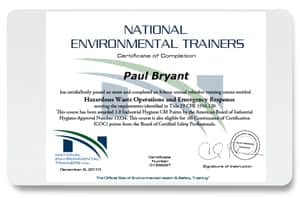40 Hour HAZWOPER Card
Anyone who enters a HAZWOPER site must recognize and understand the potential hazards to health and safety associated with the cleanup of that site. Personnel actively involved in cleanup must be thoroughly familiar with programs and procedures contained in the 40 hour HAZWOPER Site Safety Plan and must be trained to work safely in contaminated areas. Usually, a 40 hour HAZWOPER Card is given to individuals who have completed the training. Visitors to a site must receive adequate training on hazard recognition and on the site's Standard Operating Procedures to enable them to conduct their visit safely.

The objectives of training programs for employees involved in hazardous waste site activities are:
- To make workers aware of the potential hazards they may encounter.
- To provide the knowledge and skills necessary to perform the work with minimal risk to worker health and safety.
- To make workers aware of the purpose and limitations of safety equipment.
- To ensure that workers can safely avoid or escape from emergencies. The level of HAZWOPER training provided should be consistent with the worker's job function and responsibilities. The training program should involve both classroom instruction in a wide range of health and safety topics and "hands-on" practice. Hands-on instruction should consist of drills in the field that simulate site activities and conditions. Any training program for work around hazardous substances should also incorporate onsite experience under the direct supervision of trained, experienced personnel. All HAZWOPER training information should be presented in clear, concise language. Particularly important information, such as the Standard Operating Procedures, should be provided in writing.
A variety of teaching aids (i.e., films, tapes, slides, etc.) should be used, and lecture sessions should be interspersed with class participation and hands-on training. All employees should also complete refresher training, at least annually, to reemphasize the initial training and to update workers on any new policies or procedures. Employees should not engage in field activities until they have been trained to a level commensurate with their job function and responsibilities and with the degree of anticipated hazards. General site workers, such as equipment operators, general laborers, technicians, and other supervised personnel, should attend training sessions that apply to their individual jobs and responsibilities, as well as training sessions that provide an overview of the site hazards and the means of controlling those hazards.
Their training should include classroom instruction in the following subject areas, depending on their individual jobs:
- Site Safety Plan.
- Safe work practices.
- Nature of anticipated hazards.
- Handling emergencies and self-rescue.
- Rules and regulations for vehicle
- Safe use of field equipment.
- Handling, storage, and transportation of hazardous materials.
- Employee rights and responsibilities.
- Use, care, and limitations of personal protective clothing and equipment.
- Safe sampling techniques. In addition to classroom instruction, general site workers should engage in actual field activities under the direct supervision of a trained, experienced supervisor.
Some general site workers who may be exposed to unique hazards or who may occasionally supervise others should receive additional training in the following subject areas:
- Site surveillance.
- Site Safety Plan development.
- Use and decontamination of fully encapsulating personal protective clothing and equipment.
- Use of instruments to measure explosivity, radioactivity, etc.
- Safe use of specialized equipment.
- Topics specific to identified site activities.
Onsite management and supervisors, such as Project Team Leaders, who are responsible for directing others, should receive the same training as the general site workers for whom they are responsible, as well as additional training to enhance their ability to provide guidance and make informed decisions.
This additional training should include:
- Management of hazardous waste site cleanup operations.
- Management of the site work zones HAZWOPER Training Programs Health and safety staff with specific responsibilities for health and safety guidance on site should be familiar with the training provided to general site workers and their supervisors, and should receive advanced training in health and safety issues, policies, and techniques.
Visitors to the site (including elected and appointed officials, reporters, senior-level management, and other interested parties) must also receive a briefing on safety. These visitors should not be permitted in the HAZWOPER Exclusion Zone unless they have been trained, fit-tested, and medically approved for respirator use. All other visitors should not enter the Exclusion Zone; rather, they should observe site conditions from the clean area, e.g., using binoculars.

